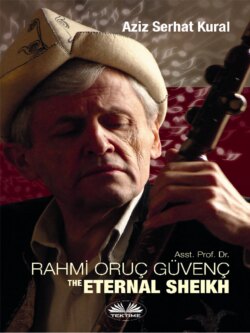Читать книгу ASST. PROF. DR. RAHMI ORUC GUVENC - Aziz Serhat Kural - Страница 5
ОглавлениеETHNIC ORIGINS AND CHILDHOOD
“One side of my family lineage is from Kazan Turks, the other side from Kyrgyz Turks. We would listen to music performed by our family from early childhood and this music (pentatonic music) became essential for me.”3
Before moving on to the musical aspect of Oruc Bey’s life, I want to tell you a little about his ethnic origins. As the above quotation says, Oruc Bey had Central Asian ancestry. His father, Ahmet Kamil Guvenc, was born into a family that migrated from Tatarstan to Tavsanli/Kutahya during the 93 war4. A short biography of Ahmet Kamil Guvenc, written by Yasar Guvenc, elder brother of Oruc Bey and Ahmet Kamil Guvenc’s other son, provides some important details:
“Ahmet Kamil Guvenc was born into a family that had migrated during the 93 war and settled in Hamitabat Village close to Tavsanli5. His father Abdussukur was martyred in the war of the Dardanelles, which was why his they came with their mother to Tavsanli. As a young man, Ahmet Kamil repaired watches and gramophones and he sold bicycles, gramophones and watches. In 1948, he brought out the ‘Tavsanli Post’ (Tavsanli Postasi) newspaper, which was published daily and weekly for over 40 years.
“In 1952, Ahmet Kamil Guvenc established the first printing house in Tavsanli and trained many typographers. He put a lot of effort into developing Tavsanli and started a campaign for the reforestation and reorganization of an area called Mulayim Dede6. He published 2 books, ‘Garden of Thorns 1‘and ‘Garden of Thorns 2’ (Dikenli Bahce-1 and Dikenli Bahce-2), which depicted the residents and workers of Tavsanli. Later, he published a book called Old-New Riddles and Turkish Poems7’. In 1978, he built and moved into a house on the road to Dedeler Village, which was later named Kamil Guvenc Avenue, and he would walk to Tavsanli and back every day to keep fit. He was awarded certificates of gratitude by the Kutahya Journalists Association and the Tavsanli Municipality. In 1990, he went with his sons Oruc and Yasar to live in Istanbul, where he died on 24th Januar 2001, exactly 2 years after his wife Urkiye Guvenc, next to whom he was buried in Karacaahmet Cemeter.“
Kamil and Urkiye Guvenc
I encountered Kamil Bey personally a few times. One time was at a photography exhibition by Oruc Bey’s wife’s at Hikmet Barutcugil’s Ebru Centre (Ebristan8) in Uskudar9. I had a conversation with Kamil Bey over tea and snacks and he told me stories of his family’s migration from Central Asia. On another occasion, a television channel interviewed Kamil Bey and his wife Lady Urkiye at Oruc Bey’s place in Cerrahpasa (the Ethnomusicology Center) about their experiences during the War of Independence.
Kamil Bey displayed a humorous side to his character with his intolerance towards Oruc Bey’s diet10. One time when he came to Cerrahpasa, I accompanied him to the bus stop for his return journey and noticed that he was taking home a nylon bag of Knorr tomato soups, which made me smile inwardly. I heard from others that he would sometimes visit fish restaurants and feast on fish until late in the evening. I should mention here that fish and tomatoes are foods that Oruc Bey never ate.
(From Left to Right) Oruc Bey, Kamil and Urkiye Guvenc, his father and mother) Nejat Guvenc ( his younger brother) and Yasar Guvenc ( his elder brother)
Rahmi Oruc Guvenc, the second son of Ahmet Kamil and Urkiye Guvenc, was born in 1948. Urkiye Guvenc was a housewife and Oruc Bey was the middle of three siblings. Oruc Guvenc completed his primary and intermediate level education in Tavsanli, and his high school education in Kutahya.
Returning to the quotation at the start of this section, Oruc Bey frequently talked about how they grew up listening to pentatonic music and melodies. According to his beliefs and research, children should listen to nothing but pentatonic music until the ages of 9 or 10. As we will see in the following section ‘Oruc Bey and Music’, pentatonic music is the basic tonality of Turkish music. Before the transition to ‘makam11’ music, there was pentatonic music, a structure which is still being preserved especially in Central Asia. Pentatonic music is used in the therapy system applied at the Nordoff Robbins Centre in London, where it is held to induce feelings of self-confidence and self-determination.
3 TRT Vision magazine, August 2017, p.12
4 Ottoman-Russian War of 1877-1878, which was known as the 93 War because it corresponded to the date of 1293 in the Rumi Calendar
5 A township in the province of Kutahya in Western Anatolia.
6 An area in Tavsanli
7 These are poems formed of stanzas (M’ani) - a Turkish tradition
8 A marbling center
9 A neighbourhood in the Asian side of Istanbul
10 I will give detailed information later about the strict diet followed by Oruc Bey .
11 In pentatonic music there are 5 tones whereas in ‘makam’ music there are 7 tones
